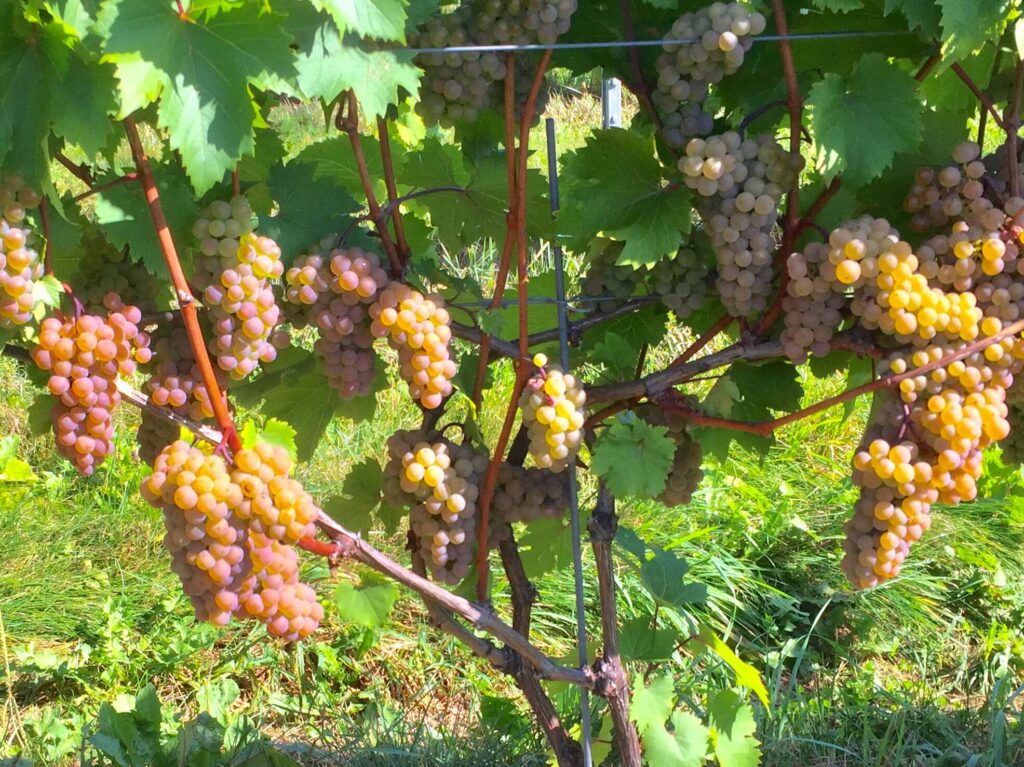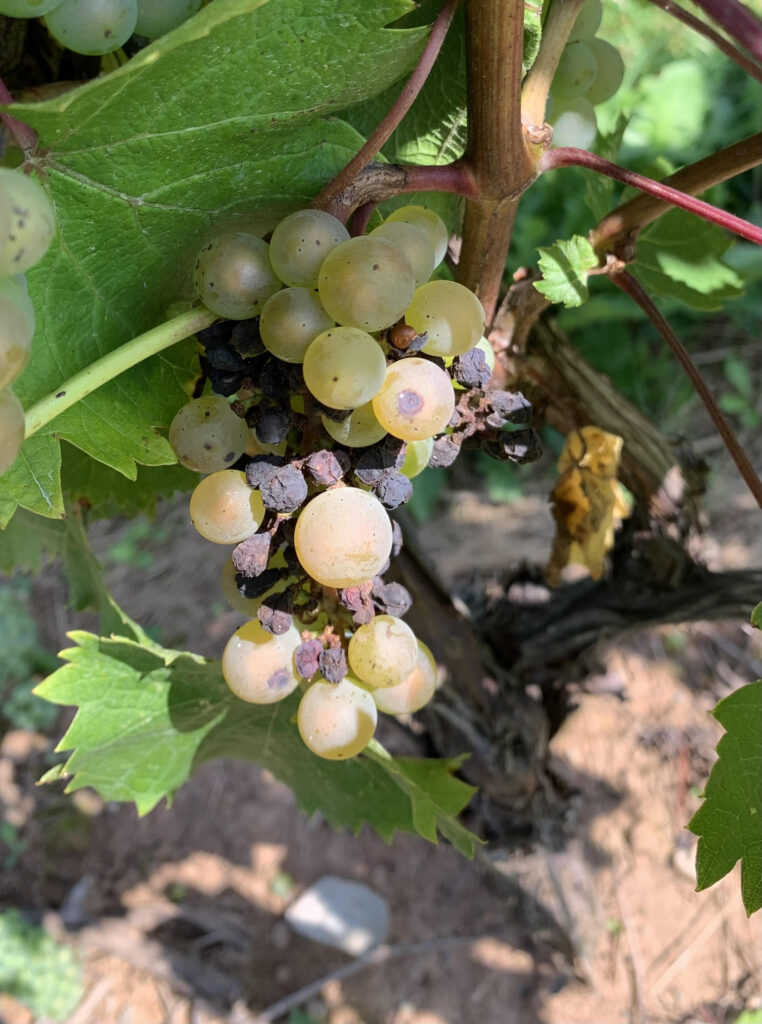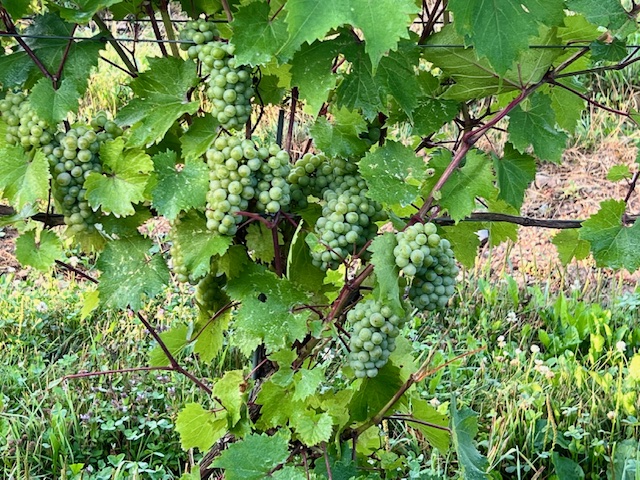At Mumana Vineyards, thinning clusters, particularly in our Petite Milo and Seyval Blanc varietals, is a key practice that ensures both the health of our vines and the quality of our wine. While it may seem counterintuitive to drop perfectly good fruit on the ground, this technique is essential for optimizing the vineyard’s output, maintaining robust, disease-resistant vines, and enabling the vines to produce the highest quality fruit.

Why We Drop Grapes
Thinning, or “dropping” clusters, is a vital vineyard management technique that balances the vine’s load. By removing some grape clusters, we allow the remaining grapes to develop more fully, delivering better ripeness, more concentrated flavours, and an overall higher quality harvest. This process also gives the vine the chance to focus its resources on fewer clusters, leading to healthier grapes with optimal sugar content and flavour profiles.
The Importance of Leaf Count
One of the critical factors we consider when thinning is the number of leaves on each vine. As a general guideline, the fruit on the vine needs 15-25 good leaves above it to ensure that it receives enough energy through photosynthesis. These leaves are essential for converting sunlight into the sugars and nutrients that the grapes need to ripen. If a vine has fewer than 15 leaves per cluster, it might struggle to ripen the fruit fully. Conversely, with too many leaves and clusters, the vine can become overloaded, leading to uneven ripening and weaker grapes. By carefully managing the leaf-to-cluster ratio, we ensure that each grape receives the optimal amount of energy, resulting in better quality fruit.
Step-by-Step Process for Choosing a Cluster to Drop
Thinning clusters is a thoughtful and deliberate process at Mumana Vineyards. Here’s a step-by-step guide to how we choose which clusters to drop to ensure the health of the vine and the quality of the grapes:
1. Assess the Vine Length
- Evaluate the Vine’s Overall Length: Start by observing the length of the vine. Longer vines can generally support more clusters, while shorter vines might struggle with the weight and resource demands of too many grapes.
- Determine the Load: Consider how much fruit the vine can realistically support based on its length. A shorter vine may only be able to support one or two clusters, while a longer vine can handle more.
2. Count the Leaves Above Each Cluster
- Check the Leaf Count: Use the guideline that each fruiting cluster needs 15-25 good leaves above it. These leaves are crucial for photosynthesis, providing the energy the vine needs to ripen the grapes.
- Compare Clusters: If a vine has multiple clusters, count the leaves above each one. If a cluster has fewer than 15 leaves supporting it, it’s a candidate for removal since it may not ripen fully.
3. Examine the Ripeness and Health of the Clusters
- Inspect for Ripeness: Look at how far along each cluster is in its development. Clusters that are significantly behind others in terms of ripeness may not catch up and should be considered for dropping.
- Check for Health Issues: Look for signs of disease, damage, or poor health in the clusters. Any clusters showing signs of black rot, mildew, or other issues should be removed to protect the rest of the vine.
- Prioritize Healthy Clusters: If a vine has more clusters than it can support, prioritize keeping the healthiest, most promising ones.
4. Consider the Vineyard’s Overall Balance
- Maintain Uniformity: As you move through the vineyard, ensure that the thinning process maintains balance and uniformity across all the vines. This helps in achieving consistent ripening and quality across the vineyard.
- Adjust Based on Microclimate: Consider the specific microclimate of the section of the vineyard you’re working in. For example, in hotter areas, you may need to thin more aggressively to prevent stress on the vine.
5. Make the Cut
- Select the Cluster: After evaluating all the factors—vine length, leaf count, ripeness, and health—identify the clusters that need to be dropped.
- Cut Carefully: Use clean, sharp shears to cut the cluster from the vine at the base of the stem. Make sure to cut cleanly and avoid damaging the vine or any remaining clusters.
6. Leave the Dropped Cluster on the Ground
- Let Nature Take Its Course: Allow the dropped cluster to decompose on the vineyard floor. This will return nutrients to the soil, supporting the long-term health of the vineyard.
- Move On to the Next Cluster: Repeat the process for each vine, ensuring that the vineyard is balanced and optimized for the best possible grape production.
This methodical approach to cluster thinning helps us maintain the health of our vines and ensures that the grapes we produce are of the highest quality, ready to be transformed into exceptional wine by our partners.
Managing Vineyard Challenges: Black Rot and More
This year, like many vineyards in our area, Mumana has faced challenges with black rot, a fungal disease that can devastate grapevines if not properly managed. Black rot thrives in warm, humid conditions, attacking both the leaves and the fruit, leading to shriveled, blackened grapes that are unsalvageable. We are fortunate to be able to counter our challenges with black rot this year, and our harvest looks lush and delicious.
At Mumana Vineyards, our management program includes regular monitoring, canopy management, and strategic thinning to combat black rot. By ensuring good air circulation around the clusters—achieved by thinning and careful pruning—we reduce the humidity levels within the canopy, making it less hospitable for fungal growth. Additionally, our careful leaf management ensures that the vines have enough energy to fight off infections and maintain healthy growth.

Our vineyard’s unique microclimate also plays a significant role in managing black rot and other challenges. While our hot microclimate can sometimes exacerbate issues like black rot, it also offers significant rewards when managed correctly. The heat helps in achieving full ripeness and developing complex flavours in the grapes, which are crucial for producing high-quality wine. By working with our microclimate rather than against it, we can reap these rewards while mitigating potential problems.
Choosing Which Grapes to Drop
Deciding which clusters to drop involves a careful evaluation of several factors:
- Vine Length: Longer vines can generally support more fruit, while shorter vines may struggle with a heavy load. We assess the vine length and remove clusters accordingly to maintain balance.
- Leaf Count: As mentioned earlier, we ensure that each fruiting cluster has 15-25 good leaves above it. This leaf count is crucial for energy production and helps the vine ripen the fruit properly.
- Ripeness and Health: We examine the ripeness and overall health of each cluster, removing those that appear underdeveloped, diseased, or too abundant for the vine to handle. This selective thinning allows the vine to channel its resources into the healthiest and most promising fruit.

The Hard Part – Letting Go
Thinning clusters can be a tough decision, especially when it means letting go of what appears to be perfectly good fruit. However, we see this practice as an investment in the vineyard’s future. By reducing the load on our vines, we not only enhance the quality of the current harvest but also contribute to the long-term health of the vines and the soil. The dropped fruit decomposes, returning valuable nutrients to the earth, which enriches the soil and supports the vineyard’s sustainability.
What to Do With Dropped Clusters
One of the most common questions we receive is what to do with the dropped clusters. It can feel wasteful to leave them on the ground, but at Mumana Vineyards, we consider these dropped grapes an essential part of our vineyard’s health. The clusters we remove are usually not ripe, meaning they aren’t suitable for any secondary use like juice or preserves. Instead, we allow them to decompose naturally on the vineyard floor.
This decomposition process enriches the soil, returning vital nutrients to the earth that support future vine growth. By leaving the dropped grapes where they fall, we’re not only promoting the health of the current vines but also investing in the long-term fertility and sustainability of our vineyard. This natural cycle of growth, harvest, and renewal is fundamental to our philosophy of sustainable viticulture.

